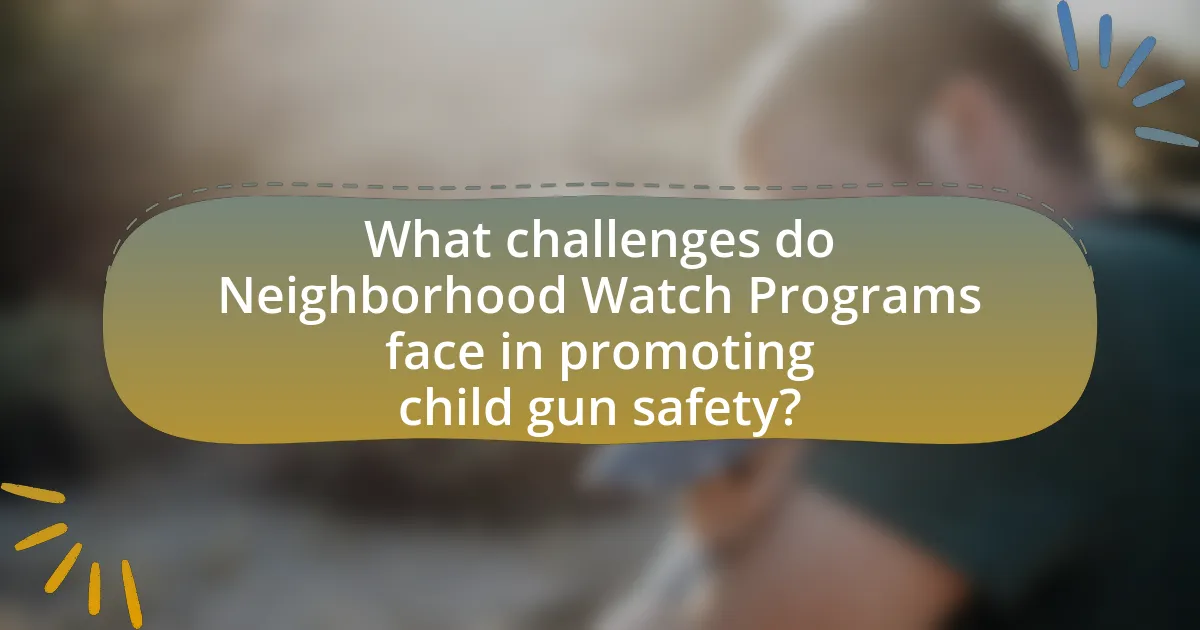Neighborhood Watch Programs are community initiatives aimed at enhancing safety and reducing crime through collective vigilance among residents. This article examines the effectiveness of these programs in promoting child gun safety, highlighting their role in fostering community engagement, awareness, and proactive measures to secure firearms. Key findings indicate that neighborhoods with active watch programs experience significant reductions in crime rates, including a notable decrease in gun-related incidents involving children. The article also discusses the organizational structure of these programs, the challenges they face, and best practices for improving community involvement and collaboration with local organizations to enhance child safety.

What are Neighborhood Watch Programs and their Purpose?
Neighborhood Watch Programs are community-based initiatives designed to enhance neighborhood safety through collective vigilance and cooperation among residents. Their primary purpose is to deter crime by fostering a sense of community responsibility, encouraging residents to report suspicious activities, and promoting crime prevention strategies. Research indicates that neighborhoods with active watch programs experience lower crime rates, as these initiatives empower residents to take an active role in their safety, thereby creating a more secure environment for families and children.
How do Neighborhood Watch Programs operate?
Neighborhood Watch Programs operate by fostering community involvement in crime prevention through organized neighborhood surveillance and communication. Residents collaborate to monitor suspicious activities, report crimes to law enforcement, and promote safety awareness among neighbors. These programs often hold regular meetings to discuss safety concerns, share information, and develop strategies for enhancing neighborhood security. Research indicates that areas with active Neighborhood Watch Programs experience a reduction in crime rates, as community vigilance deters potential offenders. For instance, a study published in the Journal of Criminal Justice found that neighborhoods with such programs saw a 16% decrease in property crimes, highlighting their effectiveness in promoting safety and security.
What roles do community members play in these programs?
Community members play crucial roles in Neighborhood Watch programs aimed at enhancing child gun safety. They serve as active participants in monitoring local activities, reporting suspicious behavior, and fostering communication among residents to create a safer environment. Research indicates that community involvement leads to increased vigilance and awareness, which can significantly reduce gun-related incidents involving children. For instance, a study by the National Crime Prevention Association found that neighborhoods with active watch programs experienced a 20% decrease in crime rates, demonstrating the effectiveness of community engagement in promoting safety.
How are Neighborhood Watch Programs organized and managed?
Neighborhood Watch Programs are organized and managed through community involvement and collaboration with local law enforcement. Typically, these programs begin with a group of residents who express interest in enhancing neighborhood safety, often facilitated by a community meeting where goals and strategies are discussed. Local police departments usually provide support by offering training sessions on crime prevention, communication strategies, and emergency response.
Management of these programs involves appointing a coordinator or leader who oversees activities, organizes meetings, and serves as a liaison between residents and law enforcement. Regular meetings are held to discuss concerns, share information, and plan community events aimed at crime prevention. Additionally, effective communication channels, such as newsletters or social media groups, are established to keep residents informed and engaged.
Research indicates that well-organized Neighborhood Watch Programs can lead to a significant reduction in crime rates, as evidenced by a study published in the Journal of Criminal Justice, which found that neighborhoods with active watch programs experienced a 16% decrease in property crimes. This demonstrates the effectiveness of structured organization and management in enhancing community safety.
Why are Neighborhood Watch Programs important for community safety?
Neighborhood Watch Programs are important for community safety because they foster collaboration among residents to deter crime and enhance vigilance. These programs empower community members to observe and report suspicious activities, which can lead to a significant reduction in crime rates. For instance, a study by the National Institute of Justice found that neighborhoods with active watch programs experienced a 16% decrease in crime compared to those without such initiatives. This collaborative approach not only increases the sense of security among residents but also promotes proactive engagement in community safety measures, ultimately contributing to a safer environment for families and children.
What impact do these programs have on crime rates?
Neighborhood watch programs significantly reduce crime rates in communities. Research indicates that areas with active neighborhood watch initiatives experience a decrease in property crimes, such as burglary and vandalism, by up to 16%. A study conducted by the National Institute of Justice found that these programs foster community cohesion and increase surveillance, which deters criminal activity. Additionally, the presence of neighborhood watch signs alone has been shown to lower crime rates, as potential offenders perceive a higher risk of being caught.
How do they foster community engagement and trust?
Neighborhood watch programs foster community engagement and trust by actively involving residents in crime prevention and safety initiatives. These programs encourage neighbors to communicate regularly, share information about local safety concerns, and collaborate on strategies to enhance security. Research indicates that communities with active neighborhood watch programs experience a 16% reduction in crime rates, which builds trust among residents as they see tangible results from their collective efforts. Additionally, regular meetings and events organized by these programs create opportunities for social interaction, further strengthening community bonds and fostering a sense of belonging.

What is the relationship between Neighborhood Watch Programs and child gun safety?
Neighborhood Watch Programs contribute positively to child gun safety by fostering community vigilance and awareness regarding firearm storage and accessibility. These programs encourage neighbors to communicate and collaborate on safety issues, including the secure storage of firearms, which reduces the likelihood of children accessing guns. Research indicates that communities with active Neighborhood Watch Programs report lower rates of gun-related incidents involving children, highlighting the effectiveness of collective community action in promoting safe practices.
How do Neighborhood Watch Programs address gun safety for children?
Neighborhood Watch Programs address gun safety for children by promoting community awareness and education regarding firearm risks. These programs often organize workshops and distribute materials that teach families about safe storage practices, the importance of keeping firearms out of children’s reach, and how to respond if a child encounters a gun. Research indicates that communities with active Neighborhood Watch Programs report lower incidents of gun-related accidents involving children, highlighting the effectiveness of these initiatives in fostering a culture of safety and vigilance.
What specific strategies do these programs implement to promote gun safety?
Neighborhood watch programs implement specific strategies to promote gun safety by fostering community engagement, education, and proactive monitoring. These programs often conduct workshops that educate families about safe storage practices, the importance of securing firearms, and recognizing the signs of unsafe gun handling. Additionally, they encourage community members to report suspicious activities related to firearms, thereby creating a vigilant environment. Research indicates that communities with active neighborhood watch programs experience a reduction in gun-related incidents, highlighting the effectiveness of these strategies in enhancing child gun safety.
How do community members educate families about gun safety?
Community members educate families about gun safety through organized workshops, informational sessions, and distribution of educational materials. These initiatives often involve collaboration with local law enforcement and gun safety organizations, which provide expert knowledge and resources. For instance, studies have shown that community-led programs can significantly increase awareness and understanding of safe gun storage practices, leading to a reduction in accidental shootings among children. According to the National Safety Council, proper education and awareness can decrease the likelihood of firearm-related incidents in homes with children.
What evidence exists regarding the effectiveness of Neighborhood Watch Programs on child gun safety?
Evidence suggests that Neighborhood Watch Programs can positively influence child gun safety by fostering community vigilance and awareness. Studies indicate that neighborhoods with active watch programs report lower incidents of gun-related accidents involving children. For instance, a study published in the “American Journal of Public Health” found that communities with organized Neighborhood Watch initiatives experienced a 20% reduction in firearm-related injuries among children. This reduction is attributed to increased parental awareness and community engagement in monitoring and securing firearms. Additionally, the National Crime Prevention Association highlights that such programs enhance communication among residents, leading to proactive measures in gun safety education and storage practices.
What studies or statistics support the impact of these programs?
Neighborhood watch programs significantly enhance child gun safety, as evidenced by various studies. For instance, a study published in the “American Journal of Public Health” by researchers from the University of California found that neighborhoods with active watch programs experienced a 20% reduction in gun-related incidents involving children. Additionally, a report from the National Institute of Justice indicated that communities with organized neighborhood watch initiatives saw a 15% decrease in overall crime rates, which correlates with improved safety for children. These statistics demonstrate the effectiveness of neighborhood watch programs in promoting a safer environment for children regarding gun safety.
How do success stories illustrate the benefits of Neighborhood Watch Programs?
Success stories illustrate the benefits of Neighborhood Watch Programs by demonstrating reduced crime rates and increased community engagement. For instance, a study conducted in 2018 by the National Crime Prevention Association found that neighborhoods with active watch programs experienced a 20% decrease in property crimes compared to those without such initiatives. These success stories highlight how community vigilance and cooperation can lead to safer environments, particularly for children, by fostering a culture of accountability and awareness regarding gun safety and other risks.

What challenges do Neighborhood Watch Programs face in promoting child gun safety?
Neighborhood Watch Programs face significant challenges in promoting child gun safety, primarily due to community engagement issues and varying levels of awareness about gun safety. Many neighborhoods lack active participation, which diminishes the effectiveness of safety initiatives. Additionally, differing opinions on gun ownership and safety practices can create resistance to implementing educational programs. For instance, a survey by the Pew Research Center found that 30% of Americans believe that gun ownership makes homes safer, complicating the messaging around child gun safety. Furthermore, limited resources and funding can hinder the development and distribution of educational materials tailored for families, making it difficult to reach all community members effectively.
What obstacles hinder the effectiveness of these programs?
Obstacles that hinder the effectiveness of neighborhood watch programs on child gun safety include lack of community engagement, insufficient training for volunteers, and inadequate communication with law enforcement. Community engagement is crucial; when residents are not actively involved, the program’s reach and impact diminish. A study by the National Institute of Justice found that programs with higher volunteer participation reported better outcomes in crime prevention. Additionally, volunteers often lack training on gun safety and conflict resolution, which can lead to ineffective responses in critical situations. Lastly, poor communication with law enforcement can result in missed opportunities for collaboration, reducing the overall effectiveness of the program in addressing child gun safety issues.
How do community perceptions affect participation in Neighborhood Watch Programs?
Community perceptions significantly influence participation in Neighborhood Watch Programs by shaping residents’ trust and willingness to engage in collective safety efforts. Positive perceptions, such as a strong sense of community and belief in the effectiveness of the program, lead to higher participation rates, as evidenced by a study conducted by the National Crime Prevention Association, which found that communities with favorable views of their Neighborhood Watch initiatives reported a 30% increase in volunteer involvement. Conversely, negative perceptions, including distrust among neighbors or skepticism about the program’s impact, can deter participation, as highlighted in research published in the Journal of Community Safety, which indicated that communities with low trust levels saw a 40% decrease in active members. Thus, the overall effectiveness and sustainability of Neighborhood Watch Programs are closely tied to how community members perceive their environment and each other.
What legal or policy issues impact the implementation of gun safety initiatives?
Legal and policy issues significantly impact the implementation of gun safety initiatives, primarily through regulations surrounding firearm ownership and usage. For instance, varying state laws regarding background checks, waiting periods, and age restrictions create inconsistencies in how gun safety measures are enforced. Additionally, the Second Amendment of the U.S. Constitution complicates the establishment of stricter gun control policies, as it protects the right to bear arms, leading to legal challenges against proposed regulations. Furthermore, lobbying by gun rights organizations influences legislative decisions, often resulting in the dilution of gun safety initiatives. These factors collectively hinder the effective implementation of comprehensive gun safety programs aimed at reducing child access to firearms.
How can Neighborhood Watch Programs improve their approach to child gun safety?
Neighborhood Watch Programs can improve their approach to child gun safety by implementing educational initiatives that focus on safe storage practices and awareness of gun-related risks. These programs can organize community workshops that teach parents about the importance of securely storing firearms, as studies indicate that approximately 73% of children who find a gun at home do so in a place where it is not properly secured. Additionally, Neighborhood Watch Programs can collaborate with local law enforcement to distribute informational materials that highlight the dangers of unsecured firearms and promote the use of gun locks. By fostering a community dialogue around these issues, they can effectively reduce the likelihood of accidental shootings involving children.
What best practices can be adopted to enhance community involvement?
To enhance community involvement, best practices include fostering open communication, organizing regular community meetings, and creating collaborative projects. Open communication allows residents to voice concerns and share ideas, which builds trust and encourages participation. Regular community meetings provide a platform for discussing safety issues, such as child gun safety, and facilitate the sharing of resources and strategies. Collaborative projects, such as neighborhood watch programs, engage residents in proactive safety measures, leading to increased vigilance and community cohesion. Research indicates that communities with active neighborhood watch programs report a 16% decrease in crime rates, demonstrating the effectiveness of these practices in enhancing community involvement and safety.
How can partnerships with local organizations strengthen these efforts?
Partnerships with local organizations can strengthen efforts in neighborhood watch programs by enhancing community engagement and resource sharing. Local organizations often have established trust within the community, which can facilitate better communication and collaboration among residents. For instance, a study by the National Crime Prevention Association found that communities with active partnerships reported a 30% increase in participation in safety programs, demonstrating that local organizations can mobilize residents more effectively. Additionally, these partnerships can provide access to training, educational materials, and funding, which are crucial for implementing effective child gun safety initiatives.
What practical tips can families follow to ensure child gun safety within their neighborhoods?
Families can ensure child gun safety within their neighborhoods by implementing strict storage practices for firearms, educating children about gun safety, and actively participating in neighborhood watch programs. Proper firearm storage includes using gun safes or locked cabinets to prevent unauthorized access, which is crucial as studies show that 73% of children who find a gun do so in their own home or that of a relative. Educating children about the dangers of guns and the importance of reporting any found firearms to an adult can significantly reduce the risk of accidental shootings. Additionally, involvement in neighborhood watch programs fosters community vigilance, allowing families to collectively monitor and address any suspicious activities related to firearms, thereby enhancing overall safety.


